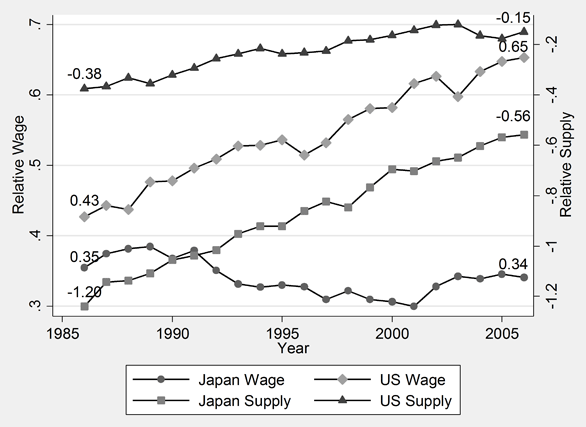| Author Name | KAWAGUCHI Daiji (Faculty Fellow, RIETI) / MORI Yuko (Japan Society for the Promotion of Science (JSPS)) |
|---|---|
| Research Project | Reform of Labor Market Institutions |
| Download / Links |
This Non Technical Summary does not constitute part of the above-captioned Discussion Paper but has been prepared for the purpose of providing a bold outline of the paper, based on findings from the analysis for the paper and focusing primarily on their implications for policy. For details of the analysis, read the captioned Discussion Paper. Views expressed in this Non Technical Summary are solely those of the individual author(s), and do not necessarily represent the views of the Research Institute of Economy, Trade and Industry (RIETI).
Human Capital (FY2011-FY2015)
Reform of Labor Market Institutions
In the United States, wage inequality has been growing continuously since the first half of the 1980s, and it is recognized as a serious social problem today. Japan has experienced no comparable expansion in wage inequality. Although wage disparities among young workers have been pointed out as problematic since the 2000s, the overall trend has been relatively stable.
The expansion in wage inequality in the United States has occurred almost in parallel with an increase in the wage gap between college graduates and high school graduates. The general consensus among academia is that technological advancement, or the development of information and communications technologies to be more specific, and the expansion of international trade and cross-border direct investments are among the major reasons behind the growing wage inequality in the United States. They believe that those factors together have caused an increase in demand for college graduates and a decrease in demand for high school graduates.
However, the development of information and communications technologies and the globalization of economic activities, cited as factors driving demand for college-educated workers, are not unique to the United States. Japan also has experienced this. Then, why has not a phenomenal increase in wage inequality comparable to the one observed in the United States occurred yet in Japan? This analysis seeks to explain these contrasting observations by the difference in the pace of increase in the number of college graduates--i.e., the pace of increase in the supply of college-educated workers--between the two countries.
A comparison between Japan and the United States in the postwar period shows that while the proportion of college-educated workers has been higher consistently in the United States, the pace of increase in the supply of such workers in Japan has been roughly twice as fast as in the United States. In explaining the rapid increase in the college enrollment rate in Japan, we need to take heed of a drastic decrease in the number of births after the postwar baby boom (1947 through 1949) and the secular trend of declining fertility after their children were born in the first half of the 1970s. While these factors have led to a decrease in the population of 18-years-olds, the overall enrollment capacity of four-year colleges has expanded gradually over the postwar decades. As a result, the number of those wishing but unable to attend college has decreased, leading to an increase in the college enrollment rate.
Meanwhile, in the United States, the postwar baby boom continued much longer into around 1960. In terms of enrollment, state universities are the mainstream of the U.S. college education system. Since their operations are heavily subsidized by taxpayers' money, changes in the enrollment capacity involve a political decision-making process, meaning that they are not in the position to readily expand the enrollment capacity in response to an increase in the population of 18-year-olds. This is why the college enrollment rate in the United States drifted lower when the baby boom continued and the population of 18-year-olds increased.
We estimated changes in the demand structure for college graduates in both Japan and the United States, and then performed counter-factual simulation by applying the supply of college graduates relative to that of high school graduates in Japan to the United States and vice versa. As a result, we found that approximately one-third of the difference between the two countries in their trends of wage inequality can be explained the difference in the pace of growth in the relative supply of college graduates. This means that the remaining two-thirds are attributable to the difference in the pace of increase in demand for college-educated workers.
These findings show that the fact that Japan and the United States followed different trajectories of fertility in the postwar period has had a non-negligible impact on the trends of wage inequality in recent years by way of affecting changes in the college enrollment rate. This viewpoint of changes in the supply of college-educated workers as a factor affecting the trend of wage inequality provides a significant insight in determining future government policies for college education, particularly those concerning the overall enrollment capacity. Another notable finding is that the wage gap between college graduates and high school graduates has been greater in the United States despite the fact that its proportion of college graduates relative to high school graduates has been higher consistently than in Japan throughout the postwar period. Probably, this is the result of an interplay of various factors. But we cannot rule out the possibility that the low quality of college education and the high quality of high school education in Japan are the major reasons behind the relatively small wage gap between college graduates and high school graduates.
Given the inevitability of further technological progress and globalization, it is expected that the relative demand for college-educated workers, as compared to that for high school-educated workers, will continue to increase in the future. How the supply side responds to and meets such rising demand, both in terms of quantitative expansion and qualitative improvement, will be a critical factor that will determine the future course of wage inequality in Japan.


